CIES Football Observatory Monthly Report
Issue no. 11 - January 2016
Squad profile of the best performing national A-teams
Drs Raffaele Poli, Loïc Ravenel and Roger Besson
1. Introduction
The first CIES Football Observatory Monthly Report of 2016 analyses the characteristics of players fielded in 2015 by 50 national A-teams from around the world. The national sides have been selected according to their average FIFA ranking throughout 2015. Among them, we find 32 European associations, six from South America, six from Africa, three from Asia and three from North and Central America.
The study first compares national squads from the point of view of the age of players fielded (Chapter 2). It then examines the differences observed in terms of height and weight (Chapter 3). Chapter 4 investigates clubs where footballers were employed when they played their international games. This analysis takes into account both the localisation of the employer clubs (within, or outside of, the country represented) and the level of their league (top division or not). Finally, we study the proportion of players born outside of the country represented (Chapter 5).
The analysis covers 1,785 footballers. In 2015, a team played on average 11 matches and fielded 35.2 players. Mexico was the most active country: 23 matches played and 58 footballers used. At the opposite end of the scale, four European teams played just 7 matches: Albania, Israel, Wales and Croatia. No other country used as few players as Austria’s total of 24. In an appendix, we present the data for all of the teams.
The most used footballer in absolute terms was Michael Bradley from the United States. The Toronto FC footballer played 18 matches for a total of 1,669 minutes. The second most fielded player is another member of the United States squad: Gyasi Zardes. The Los Angeles Galaxy footballer celebrated his first cap on the 28th January 2015 and went on to play a total of 19 matches and 1,409 minutes.
2. Age
The average age of players fielded by the 50 national squads studied was 26.6. This value increases to 27.2 if we take into account the average measured on the pitch. At around 27 years of age, players have sufficient experience to exploit their full potential, whilst retaining a physical shape that permits them to maintain sustained efforts.
Important differences were observed according to country. The highest average age on the pitch was measured for Scotland: 29.0 years of age. Despite the experience of players fielded, the Scots did not manage to qualify for the final phase of the European championships. It is no doubt timely to carry out an in-depth analysis to understand the reasons for multiple failures over the past decades.
At the other end of the scale, three African teams fielded the youngest players on average: Nigeria, Ghana and Cameroon. However, this result must be analysed carefully insofar as footballers born in Africa tend to be older than they claim to be. Lying about one’s age is a common practice that implies a competitive advantage in youth categories. However, in the long term, this strategy is counterproductive as it does not provide optimum conditions for the full development of talent. This is one of the reasons for which the real potential of African squads remains untapped.
If we exclude African teams, the countries having fielded the youngest players are the Netherlands and England, with an average of 25.6 years of age. In the first case, the bias towards youth has not been a success as the Dutch failed to qualify for Euro 2016. For the English, on the other hand, the results have been more positive. The youthfulness of the players available to Roy Hodgson is the sign of a renaissance which suggests a promising future.
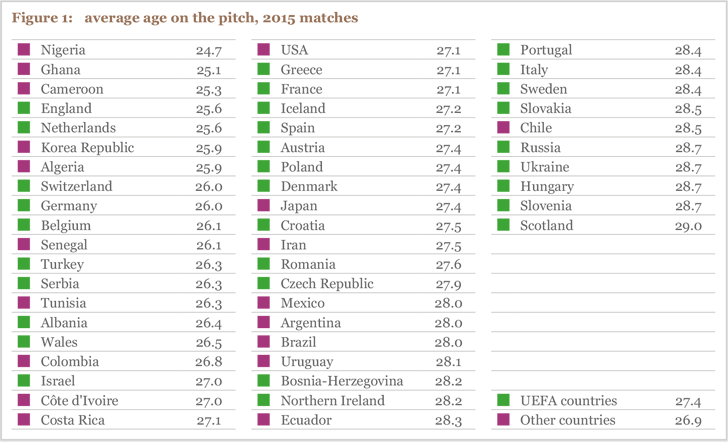
In total, footballers under 22 years of age played only 6.0% of minutes. This percentage increases to 32.5% for footballers between 22 and 25 years of age, then to 39.0% for the most represented age category: that of players between 26 and 29 years of age at the time of the match. The remainder of minutes was played by footballers over 30 years of age: 22.5%.
Important differences exist between the national squads studied. Two countries did not use any player under the age of 22: Italy and the Czech Republic. On the other hand, the fielding of young players was very high, around 20% of total minutes, for Cameroon, Turkey, England and Nigeria.
The highest percentages for minutes played by footballers aged 30 or over were measured for Slovakia (42.7%) and Brazil (41.1%). While Ján Kozák and Carlos Dunga have opted for experience, the coaches from Colombia, Belgium, Germany and England have not considered it wise to rely on players over 30. The percentage of minutes played by this category of footballers oscillates between 6 and 9%.
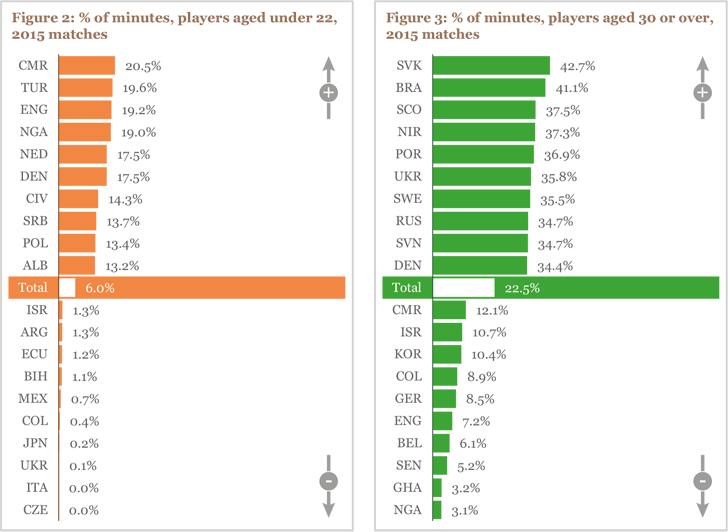
There are more than 22 years of difference between the youngest player fielded in 2015 by the national A-teams surveyed, the Romanian defender Cristian Manea (17.4 years of age), and the oldest one, the goalkeeper Gábor Király (39.6 years of age). The oldest outfield player was the Portuguese defender Ricardo Carvalho. He was 37.4 years of age during the last match played against Denmark in October.
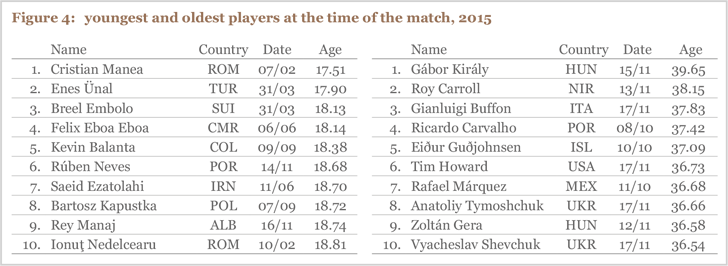
3. Height and weight
The average height of players fielded in 2015 matches by countries analysed is 181.9 cm. Significant differences exist between European national A-teams on the one hand, and South American squads on the other.
Eight out of ten teams who played on average with the tallest footballers are UEFA members. At the other extreme, the six CONMEBOL squads included in the study as well as Mexico are among the ten shortest national sides.
Spain is the only European country who fielded players with an average height of less than 180cm. By contrast, no CONMEBOL team played with footballers whose average height was over 180cm. The maximum value was measured for Colombia.
Ten centimetres separate the countries with record values in terms of average height on the pitch: Serbia (185.6cm) and Chile (175.6cm). For the Serbs, this physical attribute was not sufficient to qualify for the Euro 2016. Inversely, the short stature of the Chileans did not stop them winning the Copa América.
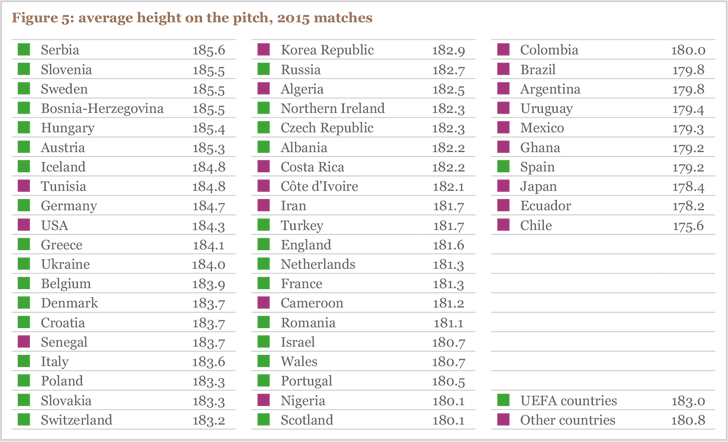
Three countries did not field players under 175cm: the German world champions, Tunisia and Slovenia. Inversely, all the teams used at least one player over 185cm. In total, the “short” footballers only played for 18.5% of minutes, while the “tall” ones played for 30.7%.
The percentage of minutes played by footballers over 185cm was less than 10% for Chile, Japan and Colombia. By contrast, this category of footballers played a majority of minutes in the Serbian, Icelandic, Slovenian and Swedish squads.
The Nigerian case is very particular insofar as two distinct player morphotypes co-exist in the national team. Indeed, players under 175cm are as well represented as those over 185cm (about 40% of minutes played in the two cases), while footballers of intermediate height are very thin on the ground (15% of total minutes).
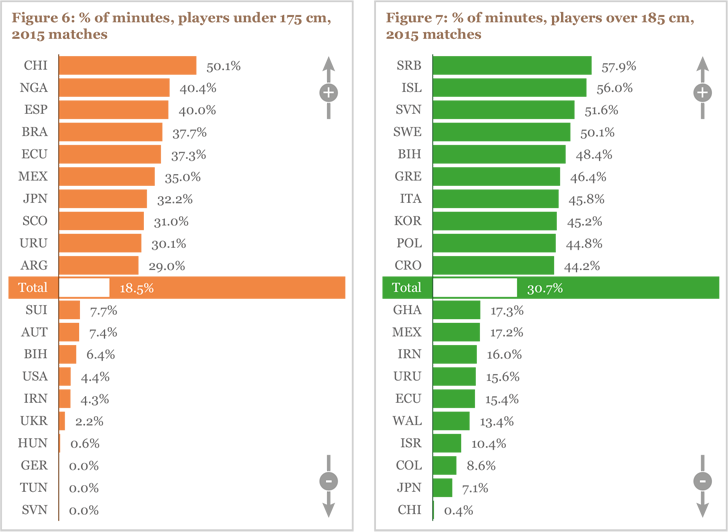
The study of players’ weight also brings to light important differences between national squads included in the study. At one extreme, the footballers used by Ecuador had an average weight of just 71.4kg. At the other end, three teams fielded players with an average weight of over 80kg: Sweden, Serbia and Hungary.
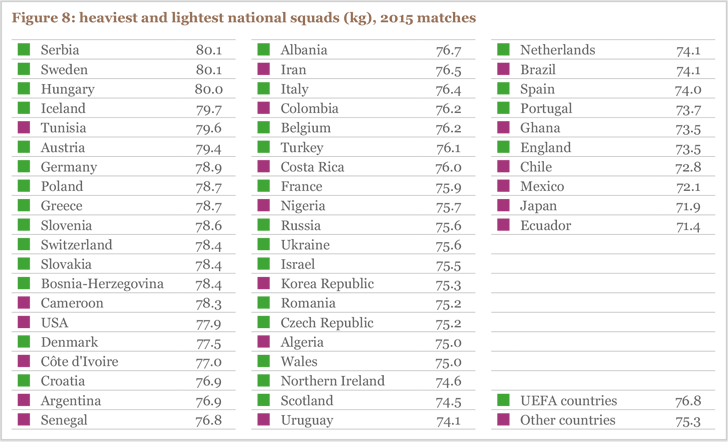
4. Employer clubs
The concentration of wealth and talent within clubs of a handful of leagues on a worldwide level explains why the proportion of footballers playing outside of the country represented is very high. On average, 68.9% of minutes played by national teams were done so by footballers playing abroad.
In only 12 cases out of 50, this percentage was lower than 50%. Most of the countries finding themselves in this situation are home to wealthy leagues, either in absolute terms (England, Italy, Germany, Spain) or within their regional area (Ukraine, Turkey, Mexico, Iran, Tunisia).
By contrast, the countries with the highest percentages of minutes played by footballers under contract with foreign clubs when matches were played do not have strong leagues from an economic point of view: Senegal, Northern Ireland, Bosnia, Ivory Coast, Albania, Iceland, Serbia, etc. In these countries, only footballers playing abroad have any real chance of being selected.
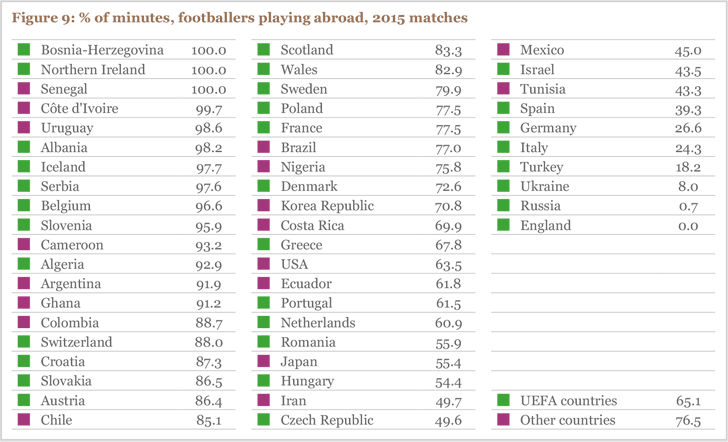
Generally speaking, it also appears that playing in top division leagues is a practically sine qua non condition to represent one of the top 50 national squads. The percentage of minutes played by footballers under contract with top division clubs is over 90% for both UEFA and non-UEFA member associations.
This percentage is less than 80% only for three United Kingdom squads: Northern Ireland (54.5%), Scotland (62.1%) and Wales (67.1%). A significant proportion of footballers representing these teams play in the second English competition level: the Championship. The latter, however, has nothing to envy over numerous top division leagues, either sportingly or economically.
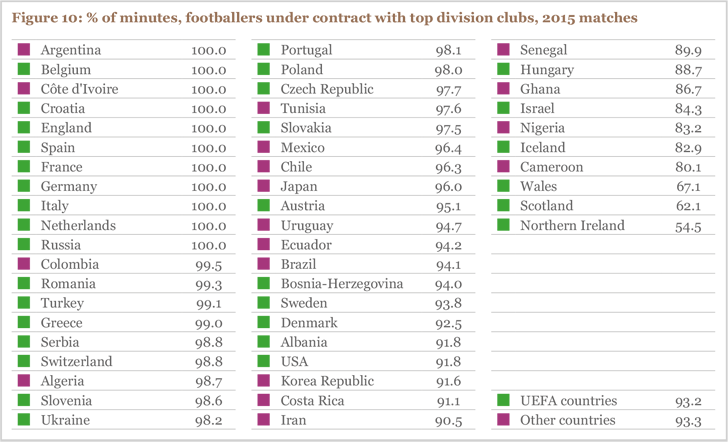
Almost half of minutes (46.4%) played in 2015 by the national A-teams analysed were by footballers employed by teams participating in the big-5 European leagues: the English Premier League, the Spanish Liga, the Italian Seria A, the German Bundesliga and the French Ligue 1. This finding also reflects the high concentration of both wealth and talent at worldwide level.
Only one country did not field footballers playing in the wealthiest leagues in the world: Iran. On the other end of the scale, England only fielded big-5 league players. All the footballers used by Roy Hodgson were part of Premier League clubs when the matches took place.
The percentage of minutes played by footballers in the big-5 leagues was over 80% for seven European nations: England, Germany, Italy, France, Spain, Switzerland and Belgium. These are surely the favorite teams for the Euro 2016 tournament.
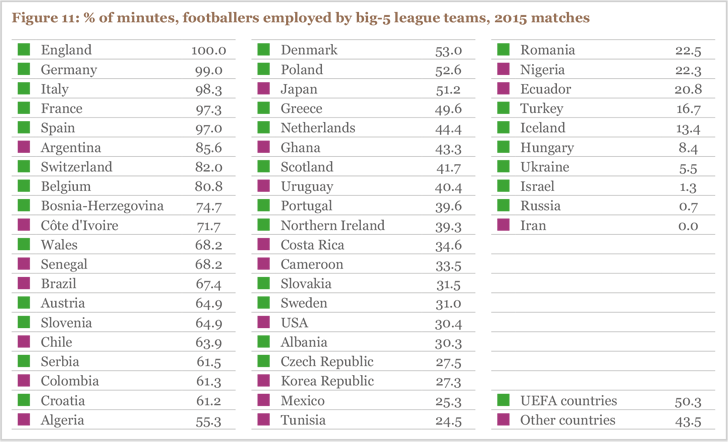
5. Place of birth
Many of the players fielded in 2015 by the national sides studied were born outside of the country they represent. In total, these footballers represent 11.3% of squads. The number of footballers born abroad varies considerably according to team. Two countries are particularly active in the repatriation of foreign-born players: Algeria and Albania.
In the Algerian case, only 40% of minutes were played by footballers born there. Of the 35 footballers fielded in 2015, 21 were born in France. For Albania, footballers born in the country only played 43.3% of minutes. Out of the 30 players used, 17 were born abroad: seven in Switzerland, seven in Kosovo, one in Norway, one in Germany and one in Macedonia.

Fourteen other countries, whether European, South American, North American or African, fielded at least five players born abroad: Bosnia, Ghana, France, Nigeria, United States, Wales, Switzerland, Greece, Portugal, Scotland, Senegal, Tunisia, Turkey and Chile. In the global era, these examples are likely to become more common in the future.
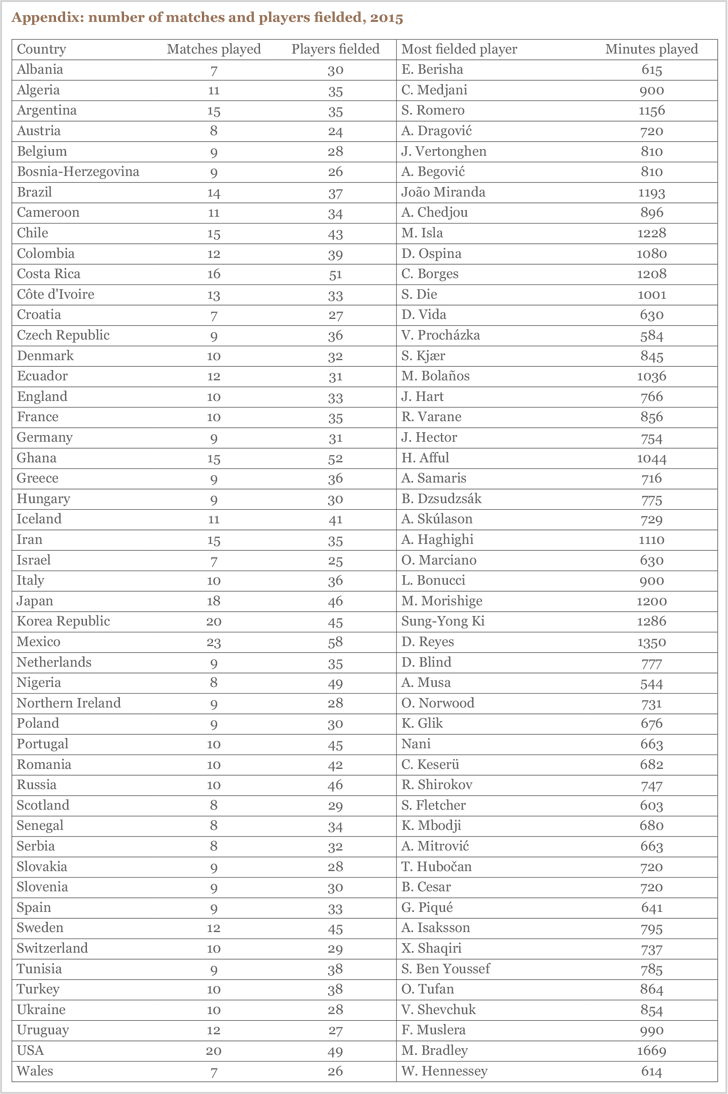
Monthly Report 11 - January 2015 - Squad profile of the best performing national A-team